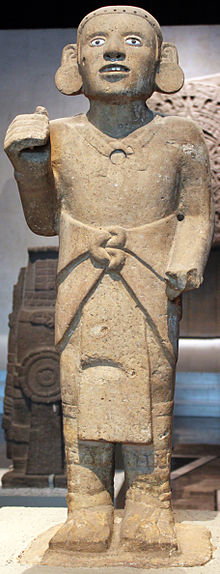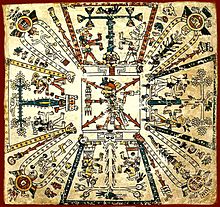Xiuhtecuhtli

Xiuhtecuhtli ( Nahuatl : The Lord of Turquoise) was the god of fire, warmth, light in the dark and food in famine in Aztec mythology . Sometimes he was also called Ixcozauhqui .
Assignments
Xiuhtecuhtli was considered to be the husband of Chalchiuhtlicues , who in turn was also called Tlaloc's wife . There was a close association between him and Huehueteotl (old god), an older personification of the fire god, so that both gods are sometimes mentioned in the same breath. However, while Huehueteotl is portrayed as old and frail, Xiuhtecuhtli appears strong and youthful. He is therefore considered the patron saint of rulership. In the Fejérváry-Mayer Codex , Xiuhtecuhtli is referred to as the mother and father of the gods and assigned to the center of the earth. The first page of the Codex Fejérváry-Mayer shows Xiuhtecuhtli in the center of a representation of a 260-day cycle that was used as a calendar in pre-Columbian Central America. Xiuhtecuhtli is therefore seen as the god of time. The picture shows rivers of blood flowing towards Xiuhtecuhtli. The blood comes from the corners of the picture and comes from the severed arm, leg, torso and head of Tezcatlipocas , which suggests that Xiuhtecuhtli created the four cardinal points by scattering his body part. Xiuhtecuhtli was Ometecutli's representative on earth. Hence, a fire burned in every Aztec household through which a connection with Ometecutli was established. On the other hand, the respective Aztec ruler was Xiuhtecuhtli's deputy in times of peace.
meaning
Nicknames like Motecucoma ( angry lord), ueue teotl (old god) and tota (father) indicate that Xiuhtecuhtli had a high-ranking position in the Aztec pantheon, which refers to the henotheistic component of Aztec polytheism . Bernardino de Sahagún describes his influence on Aztec everyday life:
- The Lord of Turquoise ... and the holy flame, that's what fire is called, or the old God and our Father. He was seen as God because he burns people ... burns the fields and is charitable in many ways: you warm yourself with him, cook with him ... burn yourself a little dry with him, burn coals with him .
literature
- Heike Owusu: symbols of the Inca, Maya and Aztecs . Schirner Verlag, Darmstadt 2000, ISBN 3-89767-073-9
- Günter Lanczkowski: The religion of the Aztecs, Maya and Inca . Scientific Book Society, Darmstadt 1989, ISBN 3-534-03222-5
- Karl Taube : Aztec and Mayan Myths . Phillip Reclam jun., Stuttgart 1994, ISBN 3-15-010427-0
- George C. Vaillant: The Aztecs . M. Dumont Schaumberg, Cologne 1957
- Eduard Seler: Some chapters from the historical work of Fray Bernardino de Sahagun . Stuttgart 1927
Web links
- Xiuhtecuhtli in the Azteccalendar (English)
Individual evidence
- ↑ George C. Vaillant: The Aztecs , page 45
- ^ Karl Taube: Aztec and Maya myths , page 55
- ^ Karl Taube: Aztec and Maya myths , page 18
- ↑ Heike Owusu: Symbols of the Inca, Maya and Aztecs , page 223
- ^ Günter Lanczkowski: The religion of the Aztecs, Maya and Inca , page 44
- ^ Eduard Seler: Some chapters from the historical work of Fray Bernardino de Sahagun , quoted from Günter Lanczkowski, page 41

